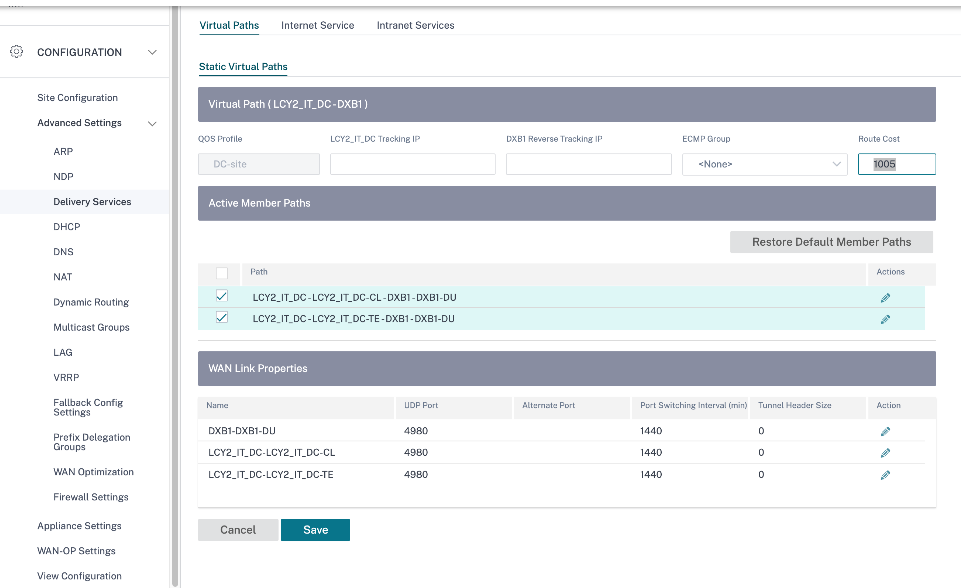Virtual Path Route Cost
Citrix SD-WAN™ supports the following routing enhancements related to data center administration.
For example, consider the SD-WAN network with two data centers; one in North America and one in Europe. You want all sites in North America to route traffic through the data center in North America and all sites in Europe to use the Europe data center. Previously, in SD-WAN 9.3 and earlier release versions, this functionality of data center administration was not supported. This is implemented with the introduction of Virtual Path Route cost.
- Virtual Path Route cost: You can configure the Virtual Path route cost for individual virtual paths that are added to the route cost when a route is learned from a remote site.
This feature invalidates or deletes the WAN to WAN forwarding Cost.
-
OSPF Route Cost: You can now import OSPF route cost (type1 metric) by enabling Copy OSPF Route Cost in the import filters. OSPF Route cost is considered in route selection instead of SD-WAN cost. Cost up to 65534 instead of 15 is supported, but it is advisable to accommodate for an appropriate virtual path route cost that is added if the route is learned from a remote site.
-
BGP - VP cost to MED: You can now copy the Virtual Path route cost for SD-WAN routes into BGP MED values when exporting (redistributing) SD-WAN routes to BGP peers. This can be set for individual neighbors by creating a BGP policy and applying it in the “OUT” direction for each neighbor.
-
Any site can have multiple virtual paths to other sites. Sometimes, if there is a Branch to which there is connectivity to services through more virtual paths, there can be two virtual paths from the Branch site. One virtual path through DC1 and the other through DC2. DC1 can be an MCN and DC2 can be a Geo-MCN, and can be configured as another site with Static Virtual Path.
-
Add a default cost for each VP as 1. Virtual Path Route cost helps associate a cost to each virtual path of a site. This helps to manipulate route exchanges/updates over a specific virtual path instead of default site cost. With this, we can manipulate which data center to be preferred for sending out the traffic.
-
Allow cost to be configured within a small range of values (for example; 1–10) for each VP.
-
Virtual path cost must be added to any route shared with neighbor sites to indicate routing preference, including routes learned via Dynamic Routing.
-
No Static Virtual Path must have a lower cost than a Dynamic Virtual Path.
Note
VP Route cost deprecates the WAN to WAN forwarding cost that existed in release versions earlier than release version 10.0. The routing decisions based on WAN to WAN forwarding costs have to be reinfluenced by using VP route cost as the WAN to WAN forwarding cost has no significance when you migrate to release version 10.0.
How to Configure Virtual Path Route Cost
To configure Virtual Path Route Cost, at the site level navigate to Advances Settings > Delivery Services > Virtual Paths > Static Virtual Paths and enter the route cost for the virtual path. All routes are installed with basic Citrix SD-WAN cost + VP route cost to influence route costs across multiple virtual paths.

Use Case:
For example, there are subnets 172.16.2.0/24 and 172.16.3.0/24. Assume that there are two data centers DC1 and DC2 that use both these subnets to transmit traffic to SD-WAN. With the default virtual path route cost, you cannot influence routing since it depends on which route got installed first it can be either the DC2 first or the DC1 next.
With virtual path, you can influence specifically DC2 virtual path to have a higher virtual path route cost (for example, 10) while DC1 has the default VP route cost of 5. This manipulation helps install routes with DC1 first and DC2 next for both.
You can have four routes, two routes to 172.16.2.0/24; one via DC1 with lower cost and then via DC2 with higher cost, and 2 more for 172.16.3.0/24.